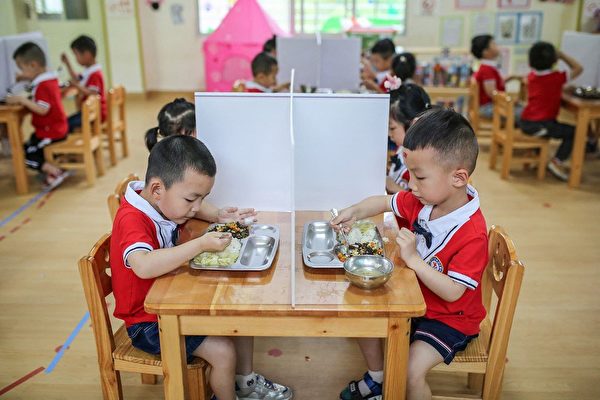In the past two years, the number of kindergartens in China has decreased by more than 20,000, with as many as 14,800 closures just last year alone. This decline could signal that the declining birth rate will plunge the Chinese economy into a huge predicament.
According to statistics from the Chinese Ministry of Education, in 2022, there were a total of 289,200 kindergartens in China, a decrease of 5,610 from the previous year, a 1.90% drop and the first negative growth since 2008. In 2023, there were 274,400 kindergartens, a decrease of 14,800 from the previous year. Over the span of two years, a total of 20,400 kindergartens across the country have closed.
Official data shows that in 2023, the number of children in kindergartens in China decreased by 5.35 million, the lowest number since 2014. With the decrease in children in kindergartens, over 170,000 full-time kindergarten teacher positions have also disappeared. According to multiple sets of research on the scale of preschool education by scholars, this significant reduction is expected to continue for at least 2 more years.
The reduction in the number of kindergartens will have a ripple effect on primary schools, middle schools, and universities. Some analysts predict that by 2035, there will be nearly 1.8 million excess primary and middle school teachers.
However, official data from the Chinese Communist Party often conceals unfavorable situations, and the actual data may be even worse.
In the past, in order to apply for the most popular kindergartens, parents would often queue up at the school gates, sometimes having to wait overnight. However, due to the declining birth rate leading to a decrease in the number of children, many kindergartens now have to resort to all means to enroll students.
With the economy slowing down and bleak youth employment prospects, many young people in China are unwilling or postponing marriage and childbirth, which could further drive down the birth rate in the future.
For Ms. Li in Jiangsu Province, money is the main concern in childcare. She is currently debating with her husband whether to send their two-year-old daughter to a public or private kindergarten.
She told Nikkei Asia, “Although education quality is important to us, we have already spent over 10,000 yuan per month on our daughter.”
“I don’t have the ability to have a second or third child now,” Ms. Li said.
According to data released by authorities this month, the number of newly married couples in China in the first half of this year decreased by 12.7% compared to the previous year, hitting a new low in recent years. This indicates that China’s demographic crisis is still deteriorating rapidly.
The Chinese authorities are trying various measures to reverse the decline in birth rates, including making it easier for couples to marry, more difficult to divorce, and attempting to reduce the costs of childbirth, childcare, and education.
However, these measures have so far shown no clear effects.
According to a report released in February by the Yuwa Population Research Institute in Beijing, the average cost of raising a child from birth to 18 years old in China is 6.3 times the per capita GDP. Among the 13 countries compared, only South Korea has a higher figure of 7.79 times. Australia is 2.08 times, the United States is 4.11 times, and Japan is 4.26 times.
Erroneous policies have exacerbated people’s economic hardship. Just before the wave of kindergarten closures, the Chinese authorities vigorously promoted the development of private kindergartens. From 2003 to 2019, the number of private kindergartens in China doubled.
Yeh Hsueh, a professor at the University of Memphis, told Nikkei Asia that this growth was driven by government policies. Around 2000, the Chinese government transformed public and collectively run kindergartens into privately owned kindergartens, known as private kindergartens. Subsequently, they also expanded private kindergartens in rural areas lacking childcare infrastructure.
Mengxi Jiang, project manager at Daxue Consulting in Shanghai, told Nikkei Asia, “Institutions investing in kindergartens have a positive expectation for China’s birth rate because China’s birth rate has been increasing year by year.”
However, since China abolished its one-child policy in 2016, the number of births has decreased for seven consecutive years until 2023, and the total population has also shrunk in the past two years.
The average age of marriage in China continues to rise, from 23.59 years in 1980 to 28.67 years in 2020. The upward trend is more pronounced for women, whose average age of marriage increased from 24 years in 2010 to 27.95 years in 2020. This also affects the number of children each woman bears.
Today, China’s population structure has undergone significant changes, forming what experts call an “inverted pyramid” — a continuous increase in the elderly population and a continuous decrease in the number of children. The number of newborns in China in 2023 has fallen from 17 million in 2017 to 9 million. In the foreseeable future, China’s annual birth rate will continue to decline, exacerbating demographic challenges and further slowing down the economy.
Darren Tay, Director of Asian Country Risk at BMI Country Risk & Industry Analysis, said in an interview with CNBC in June that over the next decade, China’s labor force will rapidly decline, causing an annual 1% decrease in GDP.
(Partial references in this article are from Nikkei Asia and reports by Nepal Aaja.)

